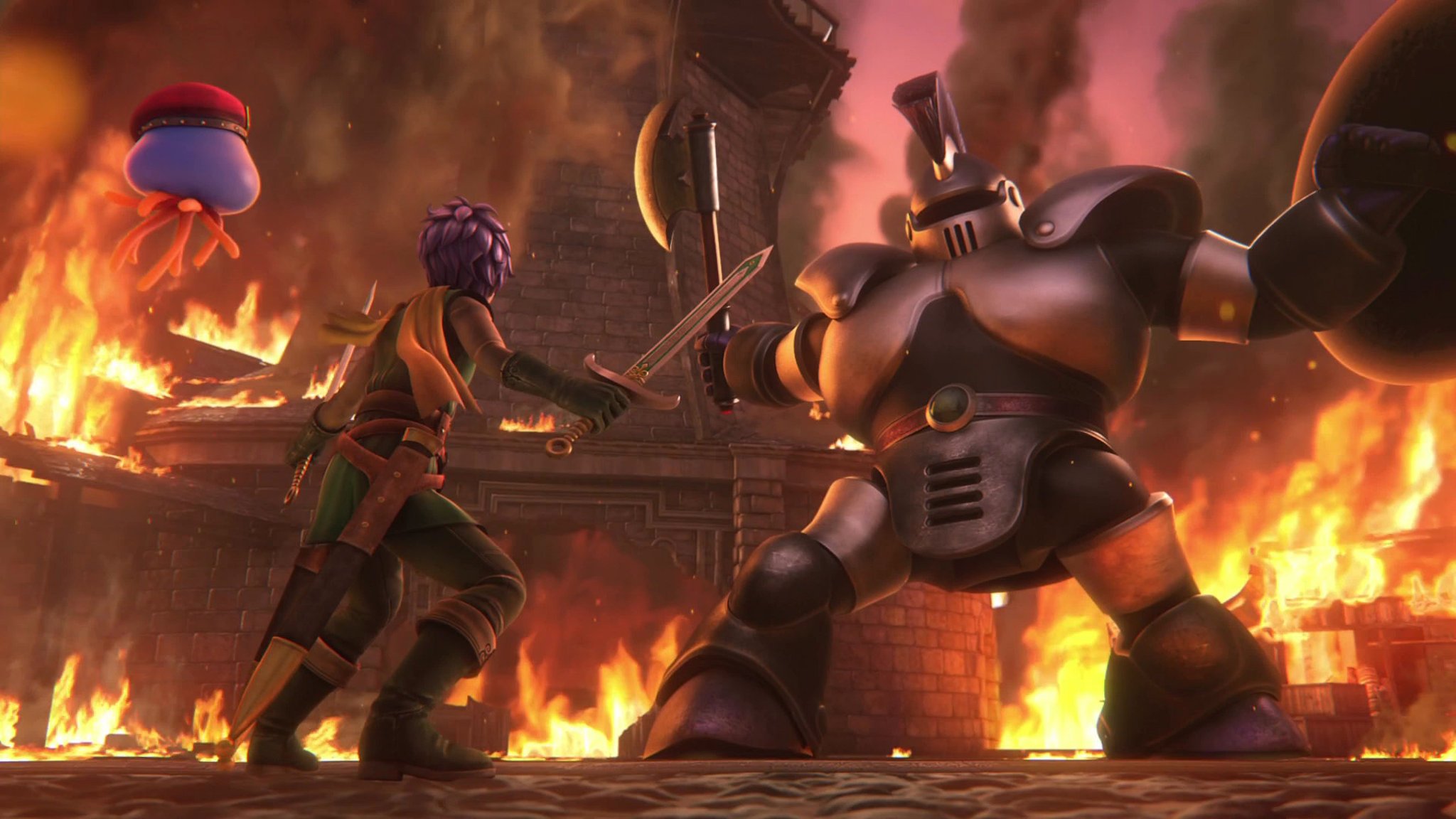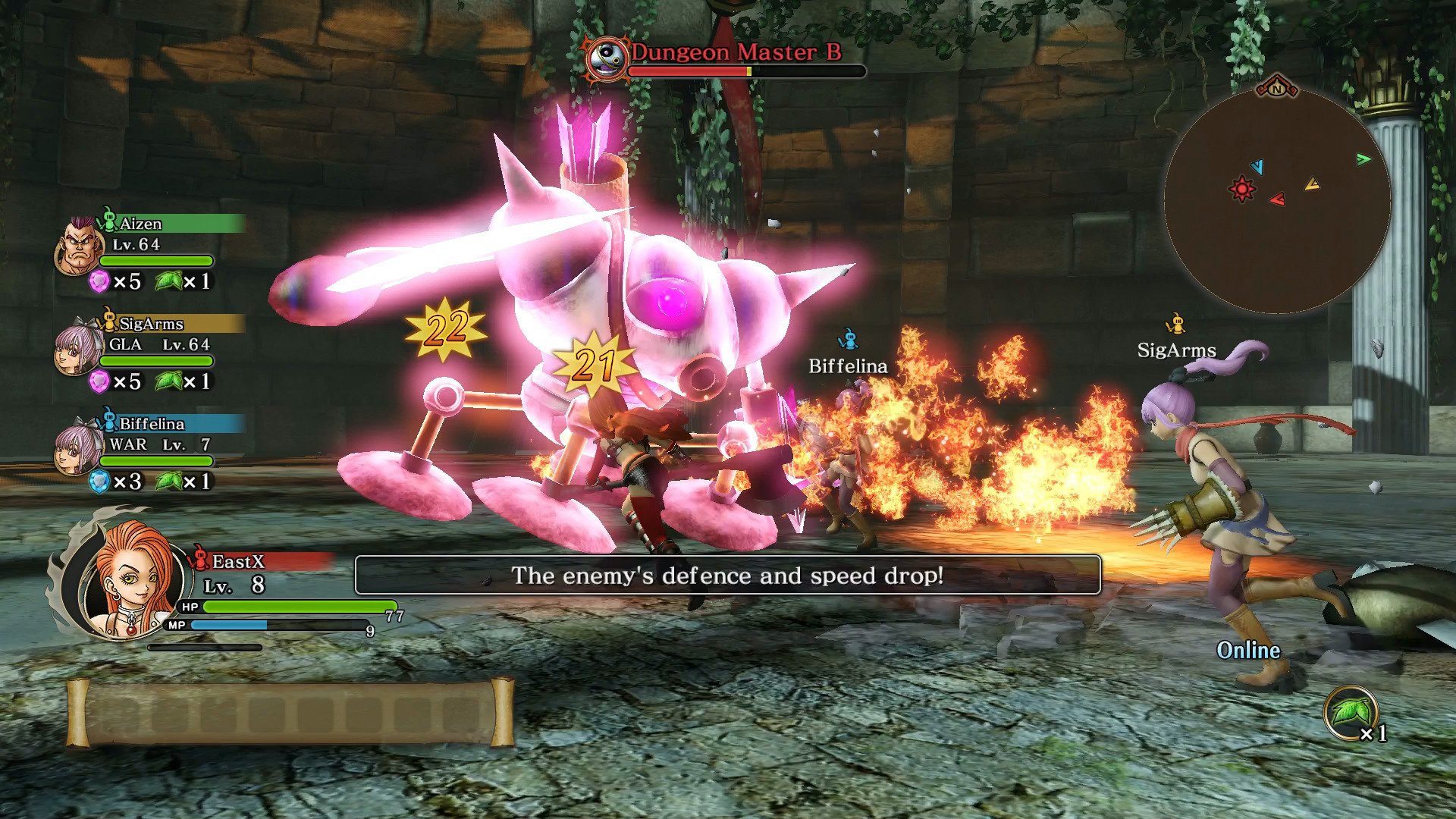
Square-Enix's Dragon Quest is a proud, long-running series of Japanese RPGs. Dragon Quest Heroes II takes its predecessor's hack-and-slash combat and beefs up the role-playing elements, resulting in a stellar action-RPG and one of the best Dragon Quest spin-offs of all time.
See on Green Man Gaming (Steam)
A dark prophecy and the bridging of worlds
Although Dragon Quest Heroes II is a sequel to the first game (also available on Steam and features guest characters from other Dragon Quests, the story is standalone and doesn't require knowledge of past games.
Before the game begins, you'll select between two protagonists (and optionally, name them), just like in the previous game. Lazarel is a young man from Dunisia who has been studying knighthood in the neighboring kingdom of Harba. Teresa, his cousin, has also been training for combat back at home. Whichever character you pick, the other still joins up as a party member during the introduction.
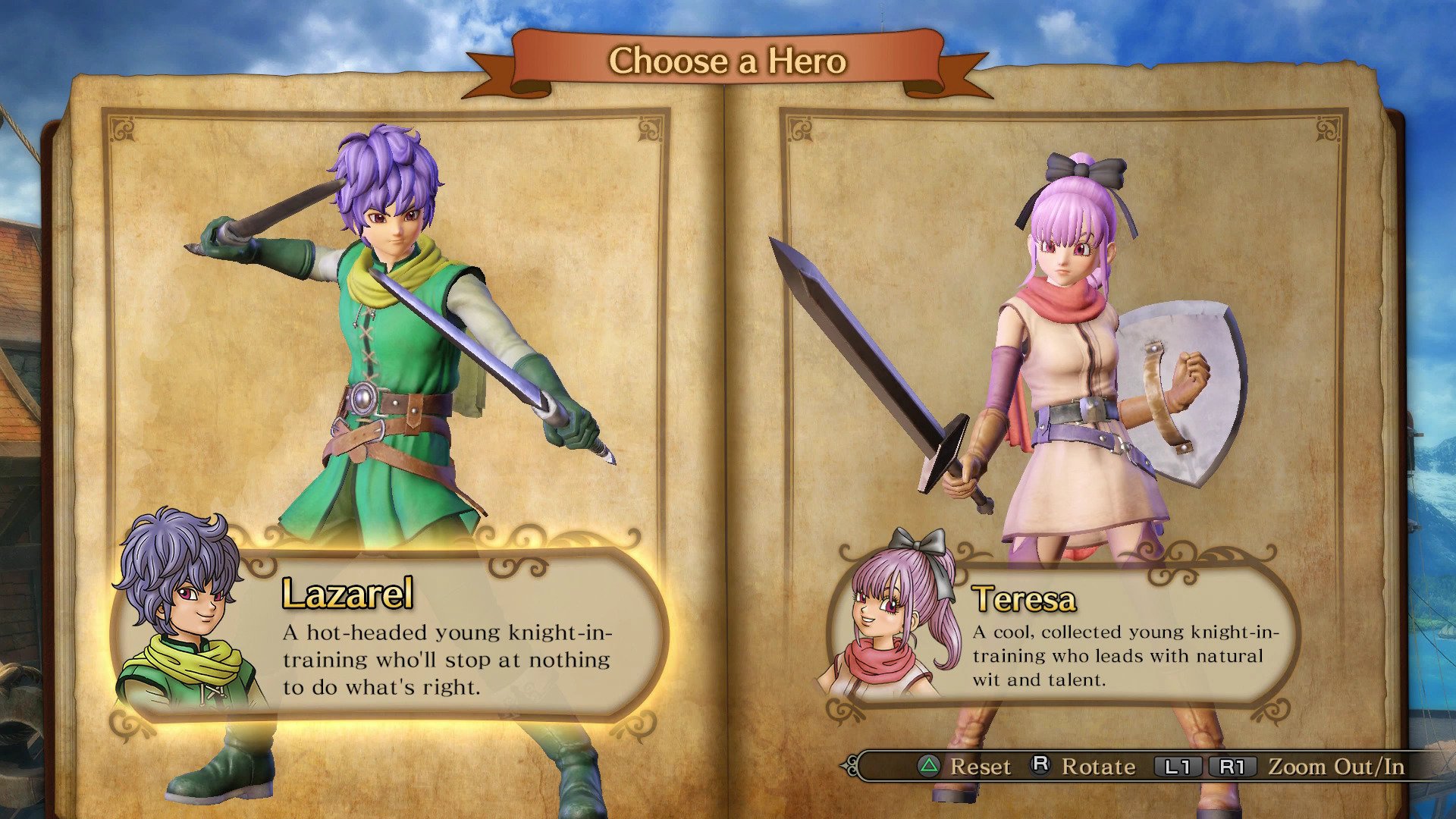
In the land of the Seven Kingdoms, peace has reigned for a thousand years. A prophecy known to all states that if war ever returns, a dragon will consume the sun and peace will be gone from the land forever.
Despite this baleful prophecy, the game opens with a surprise attack on Harba from its neighboring kingdom Dunisia. Our heroes ward off the attack with the help of Desdemona, an axe-wielding envoy from another kingdom. Soon, the three of them set out to learn the reason for the attack and hopefully negotiate peace.
Despite our heroes' best efforts, all Seven Kingdoms eventually become involved in the conflict. Meanwhile, heroes from other worlds somehow wind up in the Seven Kingdoms. They'll have to team up with Lazarel, Teresa, and friends to stop the prophecy and save the land if they ever wish to return home.
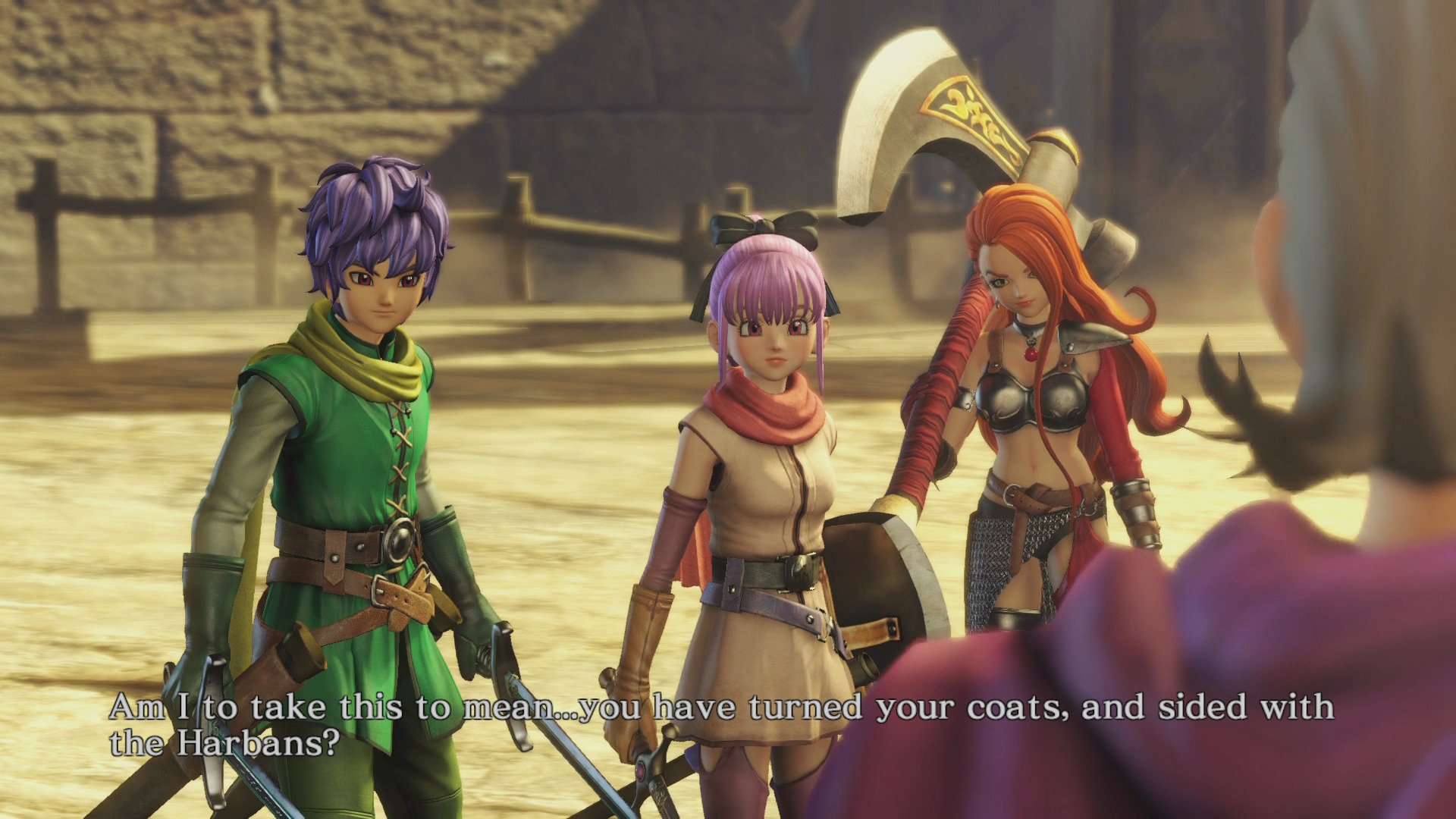
The game relies heavily on voice acting, though not all NPC dialog is voiced. Like the last game, players can select from English or Japanese voice acting. The English actors all speak in Victorian English, which can take a little getting used to. But Dragon Quest games have always used Victorian-style dialog (for better or worse), so the dub fits in well enough. Torneko's brogue is particularly charming in English.
Characters

Lazerel starts out wielding twin swords and ice magic during combat, whereas Teresa relies on a single sword and fire magic. But each of them can be made much more versatile thanks to Dragon Quest Heroes II's vocation system, a feature borrowed from mainline Dragon Quest games.
Fairly early in the game, the two primary protagonists gain the ability to switch jobs. They can choose roles like warrior, martial artist, priest, and mage. Each of these jobs has access to unique skills that offer advantages in combat. Jobs level independently, but some upgrades transfer between jobs. And upon reaching sufficient mastery with one or more jobs, players will unlock quests that lead to superior advanced jobs. The vocation system really adds a lot of customization to the game.
Your team can consist of four party members, all of whom can be switched to at any time. Once you have more than four companions, you'll be able to select active and inactive companions from the party manager in town. Building a balanced team of melee, long-range, magic-focused, and healing characters will make the game much easier.

In addition to the four original characters who make up your team, Dragon Quest Heroes II features several guest characters from past games:
- Alena, from Dragon Quest IV
- Kiryl, from Dragon Quest IV
- Meena, from Dragon Quest IV
- Torneko, from Dragon Quest IV. Torneko is so popular, he got three spin-off games of his own during the PlayStation 1 and 2 eras.
- Maya, from Dragon Quest IV
- Carver, from Dragon Quest VI
- Terry, from Dragon Quest VI
- Maribel, from Dragon Quest VII
- Ruff/Gabo, from Dragon Quest VII
- Angelo, from Dragon Quest VIII
- Jessica, from Dragon Quest VIII
For fans of the series, the guest characters are quite a treat. Additional characters for multiplayer only will arrive soon in a free update.
Combat meets the open world

Dragon Quest Heroes II relies on a modified version of Omega Factor's Warriors/Musou combat engine, which means lots of hack-and-slash fighting and hundreds of enemies on-screen at once. Think of fellow spin-off Hyrule Warriors for Wii U and 3DS, and you'll have a ballpark idea of how this works as a Dragon Quest game.
Whereas the first Heroes was fairly light on role-playing elements, the developers seriously amped up those aspects in this sequel. The game is no longer a series of action stages interspersed with visits to your camp or town.
The world in Heroes II is made up of a series of interconnected maps called wild zones, the equivalent of the world maps of a typical JRPG. Upon entering these zones, you can either make a beeline to the destination or explore it at your leisure. Each one offers lots of seamless enemy encounters, loot chests, Zoomstones (fast travel waypoints), and even paths that require specific abilities or items to open.
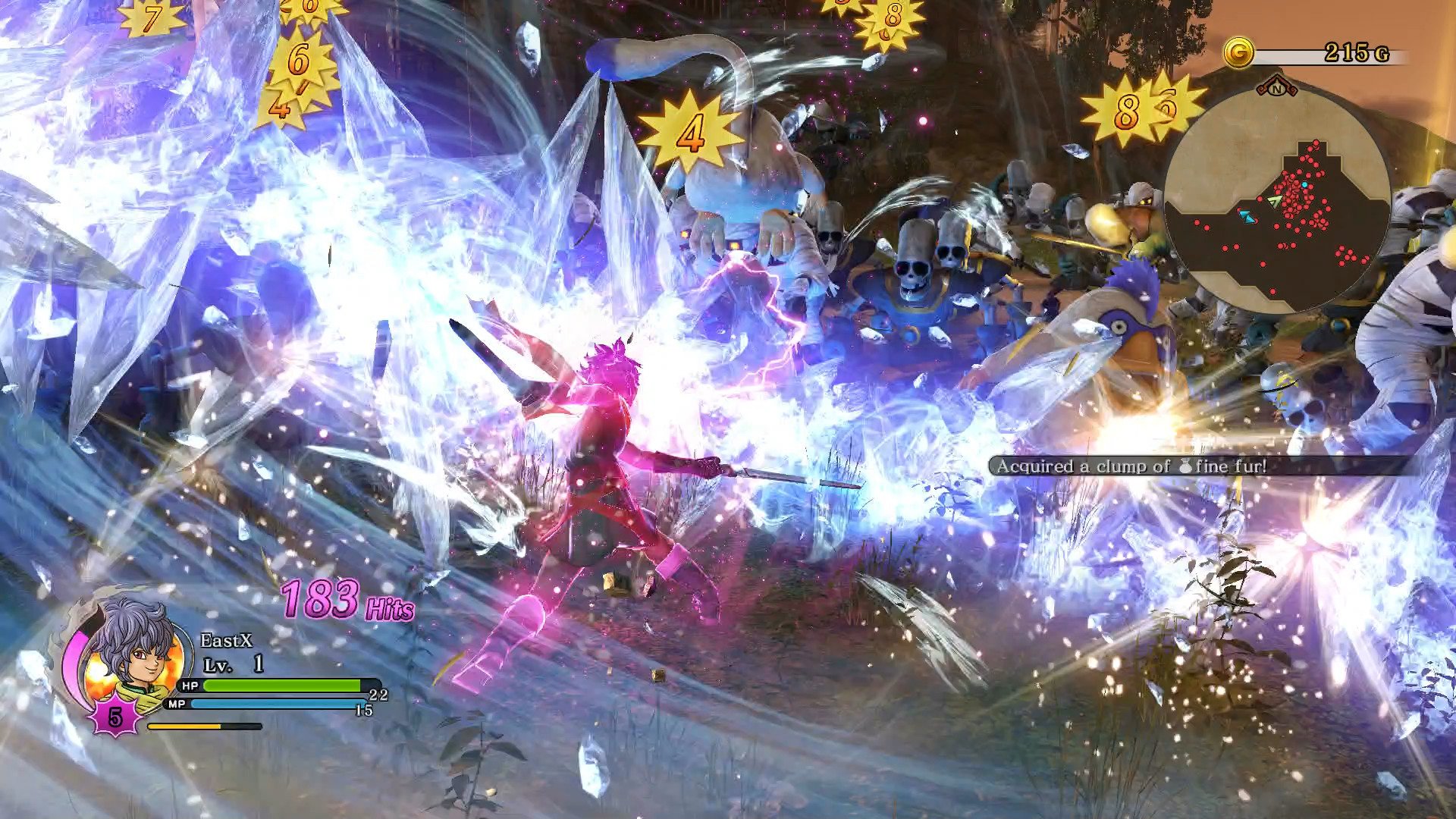
Naturally, Heroes II still features plenty of exciting war zones (action stages) in which players battle against beautiful 3D versions of iconic Dragon Quest monsters like slimes, skeletons, and golems. Combat primarily relies on two action buttons. Each character can also equip up to four spells or abilities, easily accessed by holding the abilities button. These consume MP, which recharges over time.
Dragon Quest games have always featured character designs from Akira Toriyama, creator of Dragon Ball Z. Heroes II borrows a Dragon Ball-style mechanic with the tension system. When your hero's tension meter fills up, he or she can go into high tension mode, complete with glowing pink hair and lots of electricity. Although high tension doesn't last for long, it offers brief invincibility and ends with a powerful super attack.
Monster Medals
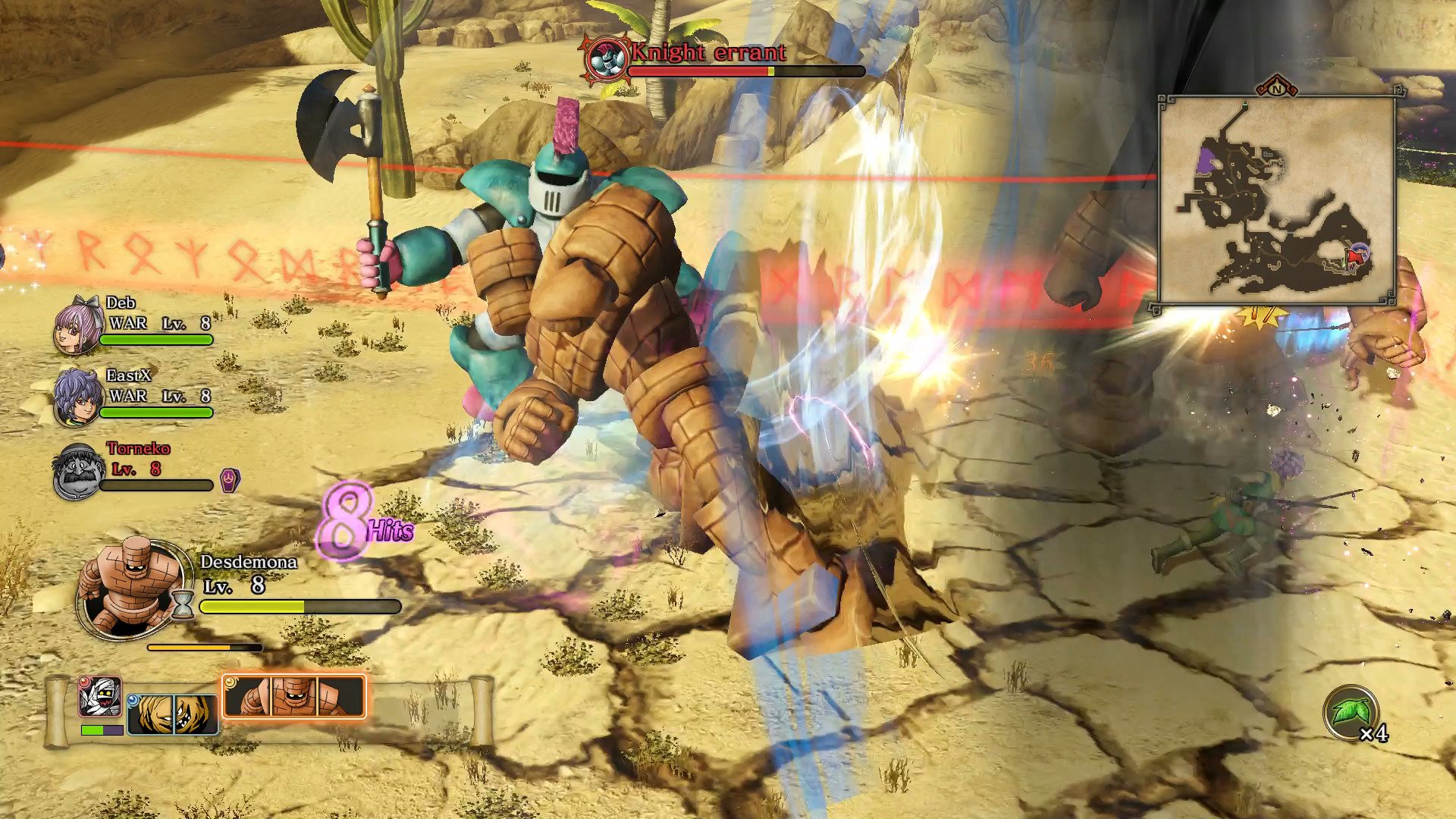
You don't just fight against those lovable Dragon Quest monsters in this game; you also recruit them. Fallen enemies sometimes drop monster medals. These come in three helpful varieties:
- Substitutes: New to this entry, you can now play as larger monsters like golems for a short duration of time.
- Sentries: Summon an AI monster to help with the battle.
- Saviors: The monster unleashes a one-time attack.
You can only carry a few monster medals at the time, and they don't carry over between areas, which encourages their frequent use. Fighting alongside or as monsters adds a nice jolt of excitement to combat.
Multiplayer
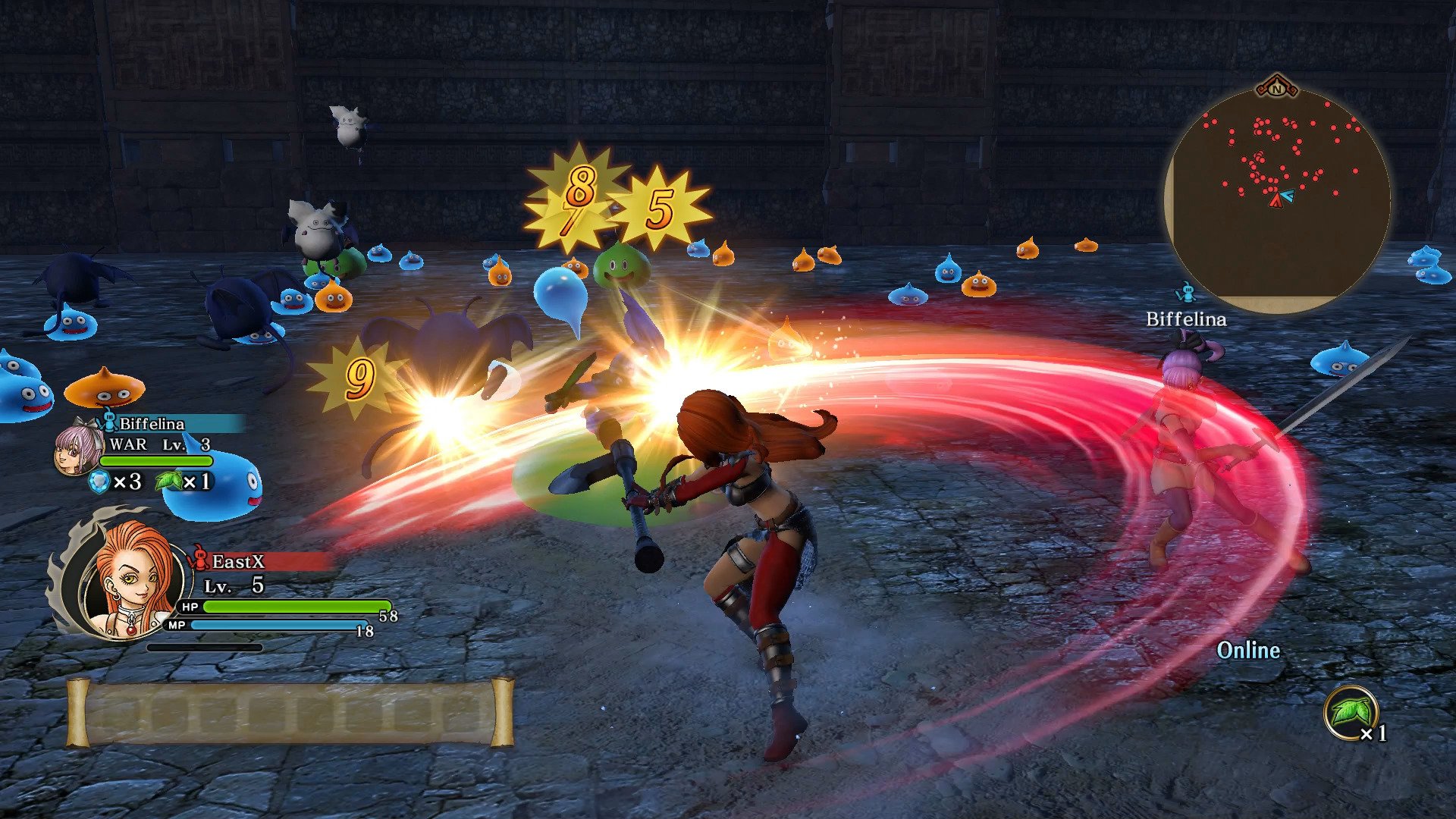
The first Dragon Quest Heroes lacked multiplayer, a standard feature of the Warriors/Musou games. Thankfully, part II brings fairly robust online multiplayer support. The feature unlocks early in the game after completing a few tasks in the city of Accordia.
Heroes II offers two primary multiplayer components. Upon starting any action stage, you can choose to recruit other players to help out in battle. These players must have already completed the same stage, so two friends can't just co-op through the whole game for the first time together. But people tend to play big RPGs like this at their own pace, so nobody should have much trouble finding friends and random players to group up with.

Multiplayer dungeons also unlock as you progress through the story and complete certain tasks. After choosing to play one of these, you'll meet up with others in a Toukiden 2-style lobby. From there, the team will venture forth into challenging dungeons that offer unique rewards. Dungeons are a great way to level up jobs, something you'd otherwise have to do against random enemies in wild zones.
Teammates can revive downed players, but it requires the use of Yggdrasil leaves. These are limited in quantity, so you can't just pick up others over and over. But downed players will revive on their own over time, and they can even cheer on living players by giving them free HP and tension.
Steam controls and system requirements
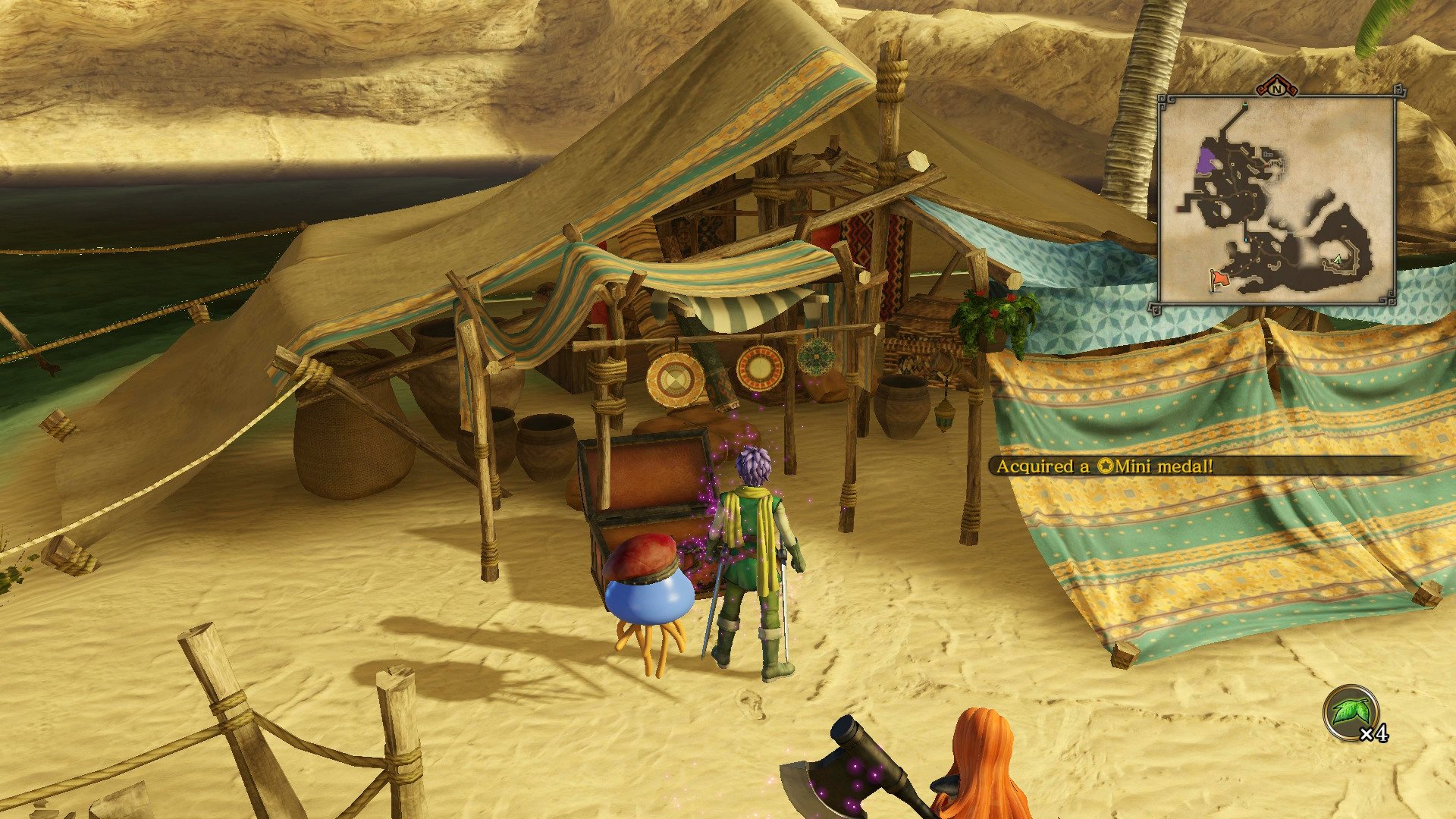
Although Dragon Quest Heroes II can be played with mouse and keyboard, you'll want to use a controller for the best experience. This is a fast-paced and action-heavy RPG designed with consoles in mind.
Minimum system requirements:
- OS: Windows 7/8.1/10 (64bit required)
- Processor: Core i7 870 2.8GHz or better
- Memory: 4 GB RAM
- Graphics: NVIDIA GeForce GTS 450 or AMD Radeon HD 5770
- Storage: 30 GB available space
The game was developed by Koei Tecmo's Omega Force. Their PC ports typically require hefty system requirements, and this one is no different. The minimum specs of a NVIDIA GeForce GTS 450 and i7 processor aren't too unreasonable, but the game won't look very pretty unless you have a beefier system. Omega Force needs to improve the optimization of its PC games in the future, but that doesn't seem to be a high priority for them.
Overall Impression
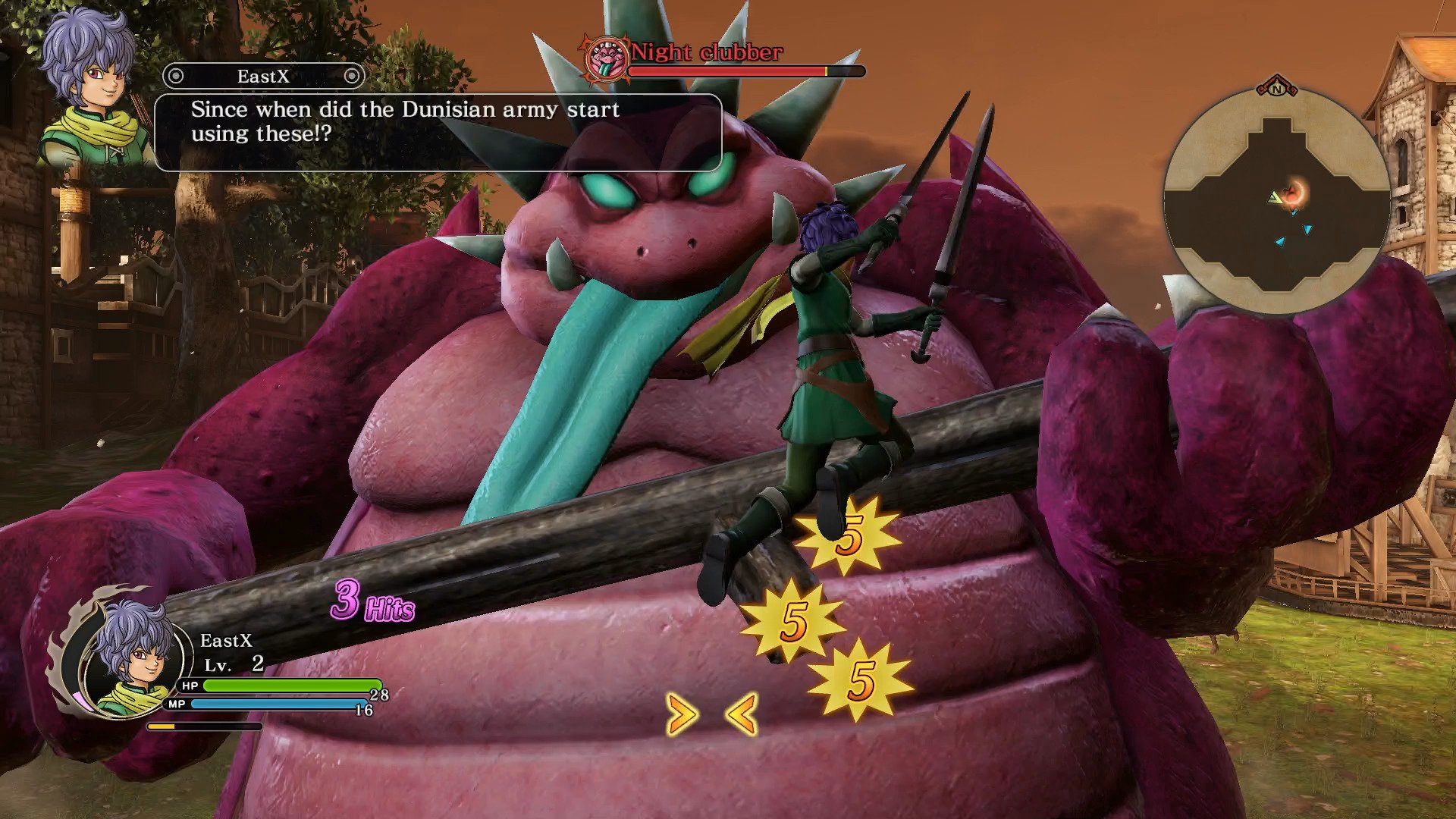
The first Dragon Quest Heroes was a fine action game spin-off of Square-Enix's venerable Dragon Quest series. Still, the focus on action combat left some RPG fans feeling underserved. Dragon Quest Heroes II fixes all that, with a vastly increased scale, explorable wild zones, playable monsters, and even co-op multiplayer. It's everything you could want in an action-RPG Dragon Quest game.
Having just played through the original Dragon Quest on my phone, I'm amazed at how expertly that game and its sequels have been brought to life in Dragon Quest Heroes II. Akira Toriyama's distinctive character designs dance off the screen and are animated beautifully in 3D. The monsters look even better; they all have so much personality and expression that you might feel a little sorry for hitting them. But hey, we can play as them too now, so it pretty much events out.
Pros:
- Simple but deep combat and open-world areas to explore.
- The Dragon Quest monsters look amazing in 3D.
- Job system allows interesting character growth and customization.
Cons:
- Boss fights sometimes go on for too long.
- The difficulty can spike and lead to failure if you don't remember to build up and prepare.
- The story is simplistic by Dragon Quest standards.
Dragon Quest Heroes is now available on Steam and PlayStation 4 for $59.99. The PlayStation 4 version is also available at retail from Amazon. It's a shame the Xbox doesn't have any Dragon Quest games yet, but at least we can enjoy the Heroes series on Steam!
See on Green Man Gaming (Steam)
Steam review copy provided by the publisher.

Paul Acevedo was formerly a Games Editor at Windows Central. A lifelong gamer, he has written about videogames for over 15 years and reviewed over 350 games for our site. Follow him on Twitter @PaulRAcevedo. Don’t hate. Appreciate!
